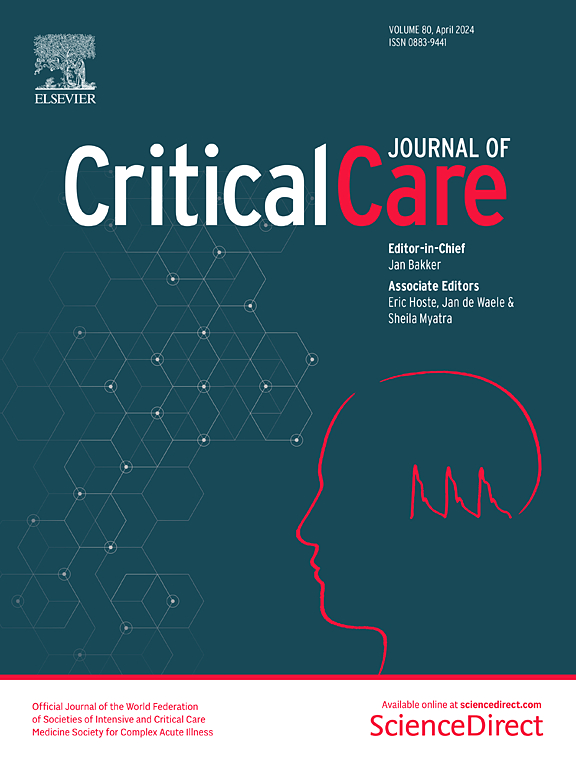快速胸按压技术对急性神经危重症患者颅内和脑灌注压的影响:一项随机对照试验
IF 8.8
1区 医学
Q1 CRITICAL CARE MEDICINE
引用次数: 0
摘要
一些研究提到了胸部物理治疗技术会导致颅内压(ICP)升高,但没有任何随机对照试验对使用有创机械通气的严重急性脑损伤患者手动快速胸外按压技术的安全性进行评估。我们的研究课题是探讨快速胸外按压技术是否会显著改变颅内压和脑灌注压。我们对接受机械通气的急性神经重症患者进行了一项前瞻性、随机、单盲对照试验。干预组接受快速胸外按压,对照组接受机械被动下肢活动。结果为颅内压、脑灌注压、血氧分压和二氧化碳分压、吸气和呼气峰值流量。2021 年 5 月至 2023 年 12 月期间,50 名患者(56.3 岁)被随机分为两组(25 名对照组和 25 名干预组),其中 66% 为女性。在任何研究时间,组间的 ICP 和脑灌注压 (CPP) 均无显著差异。组内分析显示,干预组的 ICP 和 CPP 显著下降,两组均在后恢复。对照组的 CPP 明显下降,但在最后一次测量时未达到干预前的数值。研究结束时,干预组的 PaCO2 明显低于对照组。快速胸外按压技术在使用期间甚至使用 30 分钟后都没有增加 ICP。在使用快速胸外按压技术期间,ICP 有轻微的明显下降,但在 30 分钟后达到了之前的数值。两组的 CPP 表现相似,但都没有完全恢复。试验注册:NCT03609866。注册日期:2018年1月8日。本文章由计算机程序翻译,如有差异,请以英文原文为准。
Effects of rapid chest compression technique on intracranial and cerebral perfusion pressures in acute neurocritical patients: a randomized controlled trial
Some studies refer to the increase in intracranial pressure (ICP) with chest physiotherapy techniques but without any randomized controlled trials that evaluate the safety of the manual rapid chest compression technique in patients with severe acute brain injuries on invasive mechanical ventilation. Our research question examines whether intracranial and cerebral perfusion pressures significantly change during rapid chest compression technique. A prospective, randomized, single-blinded controlled trial of acute neurocritical patients under mechanical ventilation was performed. The intervention group was subjected to rapid chest compression, and the control group received mechanical passive inferior limbs mobilization. The outcomes were intracranial pressure, cerebral perfusion pressure, blood partial pressure of oxygen and carbon dioxide, and inspiratory and expiratory peak flows. Between May 2021 and December 2023, 50 patients (aged 56.3 years), 66% females, were randomized into two groups (25 controls and 25 interventions). The ICP and cerebral perfusion pressure (CPP) did not significantly differ between the groups at any of the studied times. Intragroup analysis revealed significant decreases in the ICP and CPP in the intervention group, with posterior recovery in both groups. The CPP significantly decreased in the control group but did not reach the preintervention values at the last measurement time. PaCO2 was significantly lower in the intervention group than in the control group at the end of the study. The rapid chest compression technique did not increase the ICP during its application or even 30 min after it. The ICP showed a slight significant decrease during the application of the rapid chest compression technique but reached the previous values in the posterior 30 min. CPP had a similar behavior but did not completely recover in both groups. Trial registration: NCT03609866. Registered on 08/01/2018.
求助全文
通过发布文献求助,成功后即可免费获取论文全文。
去求助
来源期刊

Critical Care
医学-危重病医学
CiteScore
20.60
自引率
3.30%
发文量
348
审稿时长
1.5 months
期刊介绍:
Critical Care is an esteemed international medical journal that undergoes a rigorous peer-review process to maintain its high quality standards. Its primary objective is to enhance the healthcare services offered to critically ill patients. To achieve this, the journal focuses on gathering, exchanging, disseminating, and endorsing evidence-based information that is highly relevant to intensivists. By doing so, Critical Care seeks to provide a thorough and inclusive examination of the intensive care field.
 求助内容:
求助内容: 应助结果提醒方式:
应助结果提醒方式:


